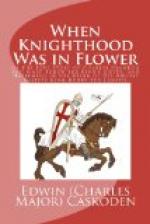The greatest beauty of Mr. Major’s story as a piece of craftsmanship is its frank show of self-knowledge on the author’s part. He knew his equipment, and he did not attempt to go beyond what it enabled him to do and do well.
His romance will not go down the ages as a companion of Scott’s, Thackeray’s, Hugo’s and Dumas’; but read at any time by any fresh-minded person, it will afford that shock of pleasure which always comes of a good story enthusiastically told, and of a pretty love-drama frankly and joyously presented. Mr. Major has the true dramatic vision and notable cleverness in the art of making effective conversation.
The little Indiana town in which Mr. Major lives and practices the law is about twenty miles from Indianapolis, and hitherto has been best known as the former residence of Thomas A. Hendricks, late Vice-President of the United States. Already the tide of kodak artists and autograph hunters has found our popular author out, and his clients are being pushed aside by vigorous interviewers and reporters in search of something about the next book. But the author of When Knighthood was in Flower is an extremely difficult person to handle. It is told of him that he offers a very emphatic objection to having his home life and private affairs flaunted before the public under liberal headlines and with “copious illustrations.”
Mr. Major is forty-three and happily married; well-built and dark; looking younger than his years, genial, quiet and domestic to a degree; he lives what would seem to be an ideal life in a charming home, across the threshold of which the curiosity of the public need not try to pass. As might be taken for granted, Mr. Major has been all his life a loving student of history.
Perhaps to the fact that he has never studied romance as it is in art is largely due his singular power over the materials and atmosphere of history. At all events, there is something remarkable in his vivid pictures not in the least traceable to literary form nor dependent upon a brilliant command of diction. The characters in his book are warm, passionate human beings, and the air they breathe is real air. The critic may wince and make faces over lapses from taste, and protest against a literary style which cannot be defended from any point of view; yet there is Mary in flesh and blood, and there is Caskoden, a veritable prig of a good fellow—there, indeed, are all the dramatis personae, not merely true to life, but living beings.
And speaking of dramatis personae, Mr. Major tells how, soon after his book was published, his morning mail brought him an interesting letter from a prominent New York manager, pointing out the dramatic possibilities of When Knighthood was in Flower and asking for the right to produce it. While this letter was still under consideration, a telegram was received at the Shelbyville office which read: “I want the dramatic rights to When Knighthood




